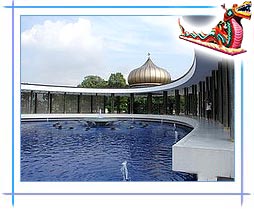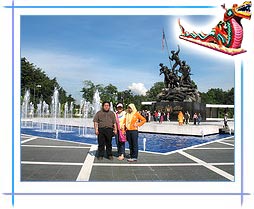Significance: National Monument of Malaysia
How To Reach: One can easily reach Tugu Negara by hiring taxis, or by boarding buses, trains from the city.
Tugu Negara is an imposing sculpture in the heart of Kuala Lumpur, along the Jalan Tugu. It commemorates the soldiers who died in Malaysia's struggle for freedom, particularly during World War II and the Malayan Emergency. The Tugu Negara literally connotes 'National Monument' in Malay. Elevated to the height of 15 meters (49.21 feet), Tugu Negara is identified as the largest freestanding bronze sculptures grouping in the world.
The monument illustrates a group of soldiers holding the Jalur Gemilang, the national flag of Malaysia, high in the
 air. Each of the
bronze figures represents elements, such as, leadership, suffering,
unity, vigilance, strength, courage, and sacrifice. Designed by Austrian
sculptor Felix de Weldon, the sculpture was built in 1966. On 8 February
1966, Tugu Negara was formally opened by the Yang di-Pertuan Agong and
declared a memorial park dedicated to 11,000 heroes who died during the
twelve-year Malayan Emergency.
air. Each of the
bronze figures represents elements, such as, leadership, suffering,
unity, vigilance, strength, courage, and sacrifice. Designed by Austrian
sculptor Felix de Weldon, the sculpture was built in 1966. On 8 February
1966, Tugu Negara was formally opened by the Yang di-Pertuan Agong and
declared a memorial park dedicated to 11,000 heroes who died during the
twelve-year Malayan Emergency. Ever since, on the Heroes Day (July 31) annually, the Prime Minister, Military Heads and the Police pay homage to the fallen heroes by laying garlands at the memorial. The monument's granite base bears the following inscriptions in English with Roman script and Malay with Jawi script: "Dedicated to the heroic fighters in the cause of peace and freedom, May the blessing of Allah be upon them."

In 1975, the monument underwent a major damage because of an explosion set off by a terrorist. However, the monument was restored to its original state soon. After erecting a fence, the complex was stated a protected area between sunset and dawn. On a daily basis, a soldier raises the national flag in evening and lowers it in morning. Encircled by a pool of water fountains and water lilies, the Tugu Negara is a nice place to spend some time in tranquility.



